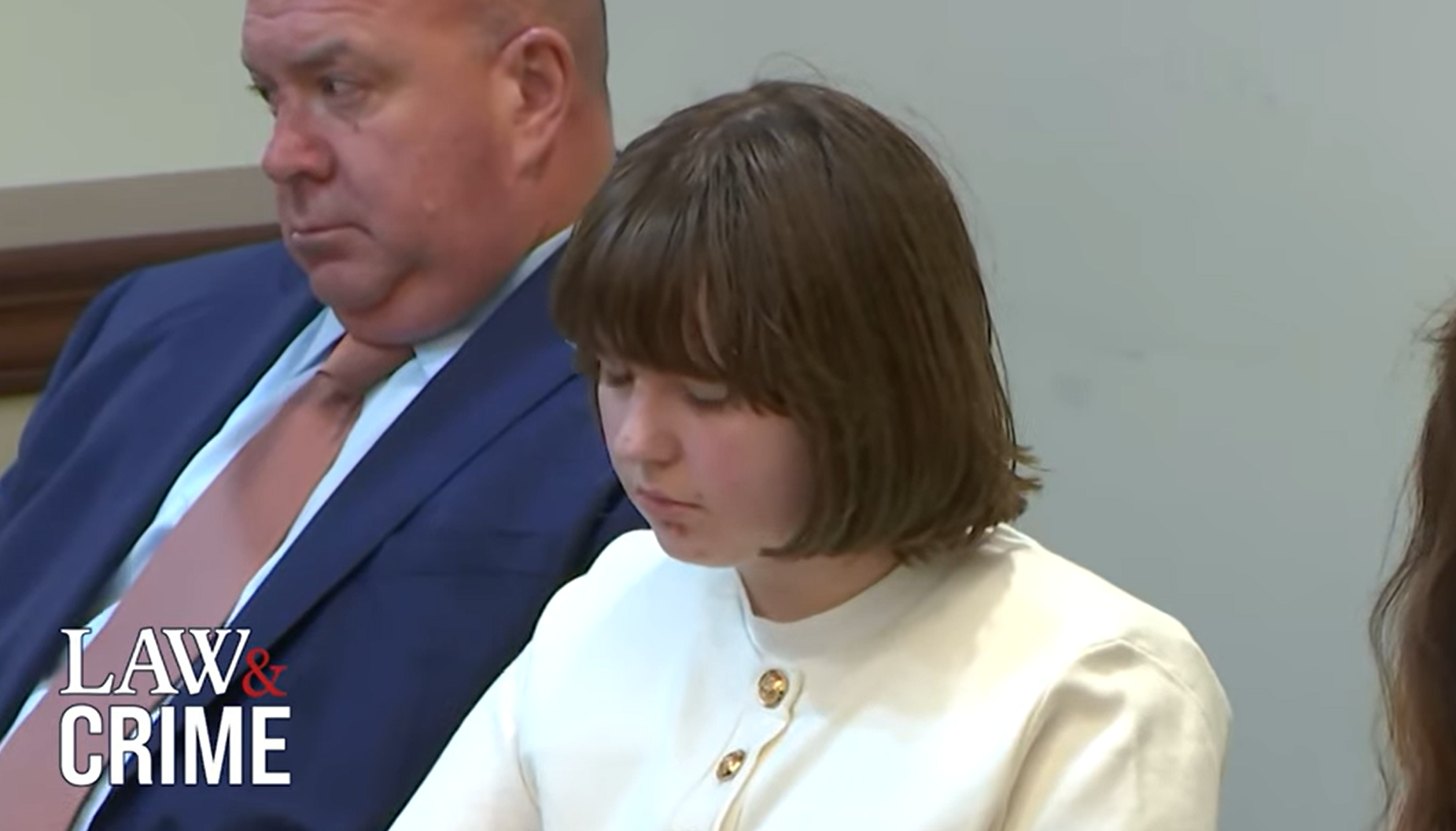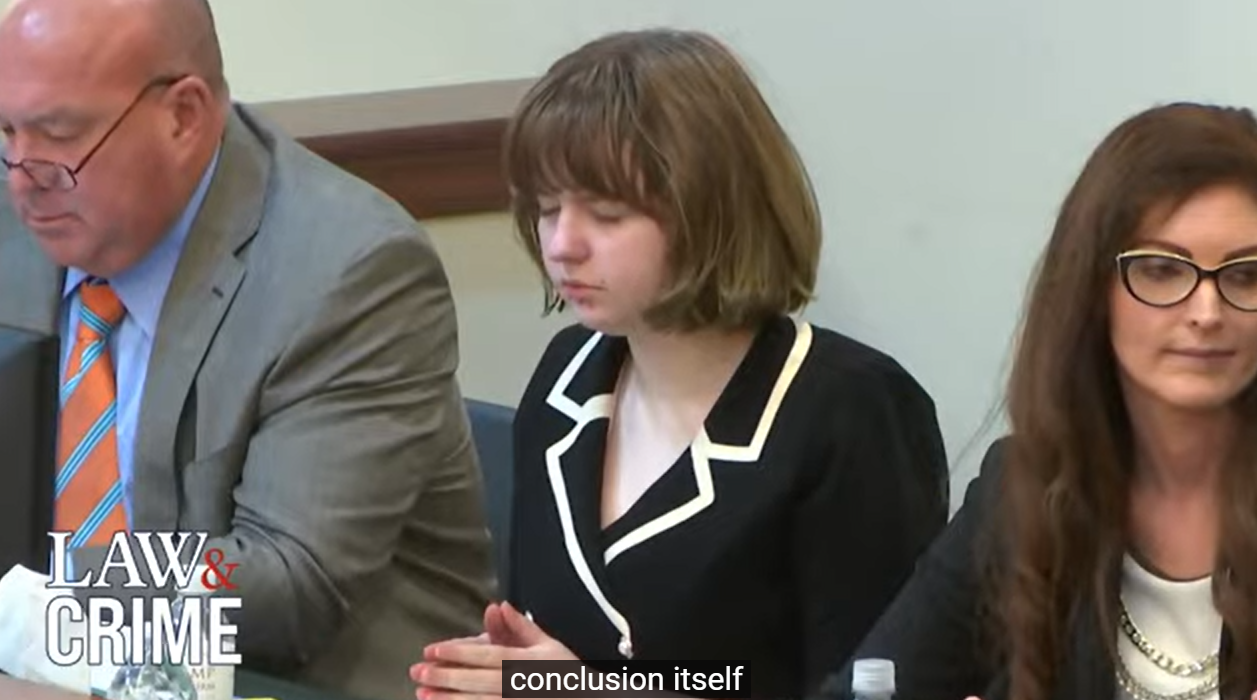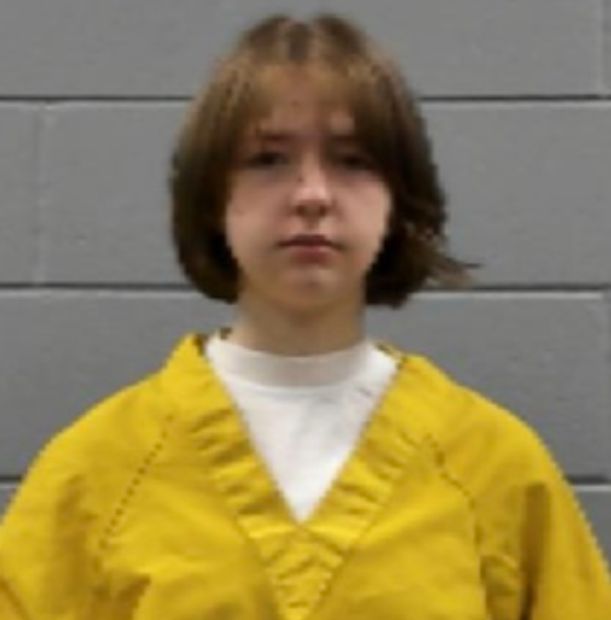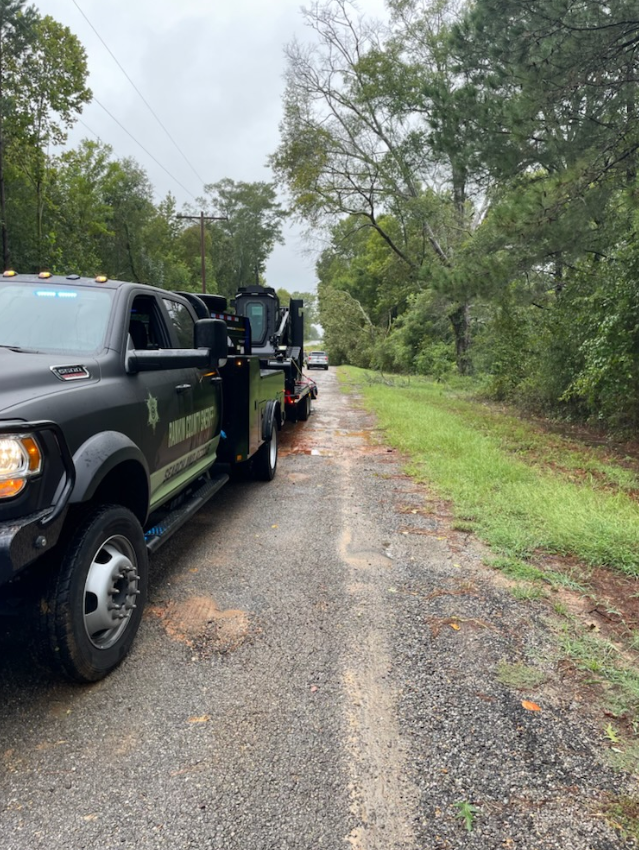(Scroll down for updates throughout the day)
Rankin County teenager Carly Gregg is in the courtroom for day 2 of her murder trial.
Her stepfather Heath Smylie is on the stand Tuesday in Judge Dewey K. Arthur’s courtroom after jurors heard the recording of his 911 call Monday. On the recording he tells dispatchers that his stepdaughter has shot her mother and shot him.
Courtroom video shows Gregg, 14 at the time of the shooting, reacting with dramatic sobs to the 911 call and the deputy’s body camera footage.
Gregg is accused in the fatal shooting of her mother, Ashley Smylie, a teacher at Northwest Rankin High School. She also is accused of shooting her stepfather.
Reportedly, one of Gregg’s friends was worried about her use of marijuana and burner phones that they had told Ashley Smylie, who later found possible vape pens in Gregg’s room. Prosecutors say that’s why Gregg shot her mother three times, then took a gun out from under her parents’ mattress and lured her stepfather home by sending him a text from her mother’s phone.
While she waited on Heath Smylie to come home, Gregg texted friends, asking some of them to come to her home and asking one, “Are you squeamish around dead bodies?”
The defense has argued that Gregg had a mental illness that neither she nor her parents knew about. They allege that Heath Smylie has taken Gregg’s side after seeing her terror at the scene of the shooting.
TUESDAY MORNING TESTIMONY
As Smylie testified, he said Carly’s terrified screaming at the scene when he found his wife shot made him believe she was “terrified out of her mind” and he went to search for an intruder. It was then that she shot at him once and he was able to get his hand on the gun, after which time it went off twice more.
He said once he took the gun from Carly, she fell back and ran out the back door. Knowing he couldn’t catch her, he locked the back door in case there was someone else outside the house.
“It was evident to me immediately that something was very wrong with Carly,” Smylie said. “The way she was screaming, the way she looked, she was moving so fast.”
Smylie then found his wife Ashley shot to death. As he described the situation, he seemed fragile, a little in shock.
“She was laying on her back with her arms over here and a towel covering her face,” Heath Smylie said of finding his wife. “I knew that she had been shot, there was blood around, I’m not sure exactly where, on the right side of her face.”
Smylie said there was a camera in the garage that he checked after his home had been released back to him when he got home from the hospital. It had videos on it that he offered police, and he said he tried to copy the card to his computer but instead moved the videos to his computer. He said when police found nothing on the cards, they told him, “We’re trying to keep from charging you with tampering with evidence.”
Smylie testified that he continued to cooperate with police for a time, but at some point stopped.
A security camera that was missing throughout the investigation was later found in the refrigerator after multiple searches by family and law enforcement. Smylie told Assistant District Attorney Katherine Newman that the last time he had seen it plugged in was the day before the incident. When he told law enforcement about the camera in the refrigerator, he gave them consent to search the camera for information, he said.
Allegations that Gregg was taking drugs were previously unknown to him, Smylie said, until police brought him some things they had taken from her room.
Smylie said he had instituted a no-contact order against Gregg after the killing, but that at some point he had spoken with her.
AFTER 10:30 BREAK TUESDAY MORNING
Coming back from the break, the defense showed security video from the garage, first that showed Ashley’s SUV coming home and Gregg getting something out of the vehicle. The next one showed Heath Smylie getting home, and the others just showed the view of the garage as screaming could be heard in the background.
Smylie said it was Carly screaming in the background, and himself yelling to ask her what was wrong when he first saw her because she looked terrified.
When asked by the defense about his marriage to Ashley, Smylie said, “We got along great,” saying he couldn’t think of anything they had disagreed on. He said Carly had told him that her biological father had tried many drugs, including having done them “constantly” in front of her, “blowing smoke in her face,” and that he had made her drink a beer when she was 12. Smylie testified that she told him that drugs were laying around all over her biological father’s home. He testified that Ashley Smylie was afraid of Carly’s father.
Smylie said Ashley Smylie and Carly had a good relationship and enjoyed a lot of similar things. He said because Ashley had lost a child previously, that she was worried about Carly being involved with things like social media and TikTok. She had an old apple device from her biological father that she had TikTok on, Smylie testified, that her family had found late last year.
He testified that his relationship with Carly was a good one, and that he loves Carly like he would a biological child. Under questioning, he said he didn’t know what reason she would have to shoot him and that she may not have recognized him.
Smylie was finished with testimony around 11:15, but was not released as a witness at that time.
CLIFF DUNLAP, RANKIN COUNTY CORONER’S OFFICE
Cliff Dunlap was called by the prosecution to the stand around 11:30 a.m. After a rundown of his background and training, and how the coroner’s office works with law enforcement, he testified to finding Ashley Smylie suffering a gunshot wound when he arrived on scene at the Smylie home in the Avalon subdivision.
Dunlap said initially, it appeared that she had two gunshot wounds, he said. She was then placed in a white sheet that would collect any evidence that might fall off during the transport process, then she was taken to the medical examiner’s office, he said.
Dunlap said the cause of death was determined to be three gunshot wounds to the head, and the manner of death was homicide.
Court has dismissed for lunch.

AFTER THE LUNCH BREAK
INVESTIGATOR TYLER BURNELL, RANKIN COUNTY SHERIFF’S DEPARTMENT
Investigator Tyler Burnell said he arrived on the scene and investigators Hunter Lewis and Dustin Smith were already there. Medical personnel were on scene at that time, too, he said.
Burnell said he walked up as Pafford Ambulance was loading Heath Smylie into the ambulance. He had been told that his stepdaughter had shot him and killed his wife, Burnell said, but no specific details. He got the information from Smith and Lewis, and Carly Gregg was not there, nor did law enforcement know where she was.
Lewis had put up the crime scene tape and begun the crime scene log, Burnell said, so he began to photograph the residence and document what he found. Heath Smylie had a through-and-through gunshot wound, he said, and the body of Ashley Smylie was found dead in Carly Gregg’s bedroom.
The prosecution introduced a diagram Burnell had drawn of the layout of the home, and he described that it was drawn for courtroom purposes since crime scene photos don’t really show a layout. He referenced the layout as he discussed the processing of the crime scene.
Burnell testified about cell phones found at the scene, as well as a holster found in the Smylies’ bedroom. There was a Taurus 357 Magnum revolver found on the counter, he said, as well as a photo with six cartridges and one live round taken from the weapon.
There were other guns in the home, he said, located in the master bedroom closet. There were also boxes for THC vape pens found in the home, he said, and among other things, a wire to a home surveillance system camera.
He detailed photos of the home that showed where Heath Smylie had walked in through the mud room and immediately encountered gunfire. Burnell pointed out “defects,” or bullet holes, where the gunfire had hit things.
Detectives collected Heath Smylie’s shirt from where medics had left it, as well as his scrub pants from the hospital, Burnell said. Projectiles were introduced into evidence, and Burnell discussed where each of them was found and the nature of the boxes they’re kept in. The bullets in Ashley Smylie’s body matched, he said.
The murder weapon, he said, was found on the kitchen counter after Heath Smylie had told detectives where it was.
THE ARREST
Burnell said Gregg was finally taken into custody using resources connected to the Rankin County/Madison interdiction unit, who were able to apprehend her and bring her back to the scene and given a gunshot residue test.
There was stippling under Ashley Smylie’s chin, Burnell said, indicating that at least one gunshot wound was within three feet of Smylie’s head as she lay on the ground.
Burnell also said there was a friend of Gregg’s who was brought forward to police that afternoon by her father, and she told authorities that Gregg had contacted her and told her it was an emergency and she needed to come to the house.
The friend’s father had dropped her off that night, like he had done so many times, Burnell said. When she got there, Gregg asked her, “Do dead bodies make you squeamish?” Gregg then took her to the bedroom to show her the body.
At that time, Ashley Smylie’s arms were crossed on her chest and the towel was over her face, the child told police. Gregg told her she had three shots for her mother and three shots for her stepfather. When the child heard the gunshots inside and saw Gregg run out of the home, she ran away behind her. The friend split off from Gregg and went to another friend’s home in the neighborhood, Burnell said.
Burnell made sure to note that investigators were careful to follow all protocols of interviewing a juvenile as they dealt with Gregg’s friend who came over that day.
CROSS EXAMINATION OF BURNELL
Attorney Kevin Camp asked Burnell about the SD cards to the garage camera and what detectives were looking for when they went back to the home. Burnell explained that deputies just wanted to know what happened to the videos from the 19th. The earlier explanation was that Heath Smylie had accidentally taken the videos off the SD card when he copied them to his computer.
Camp asked if Smylie was ever a suspect and Burnell explained that he was not, but that he would have been an additional suspect if he had lost or tampered with evidence.
The defense brought up Smylie’s previous statements that he quit speaking with the sheriff’s department and asked why Smylie would have gotten an attorney if he wasn’t a suspect. Burnell said he didn’t know whythat had happened.
“I don’t know what Mr. Smylie was thinking or what his motivations were in obtaining an attorney,” Burnell said, adding that Smylie was still cooperative after that.
Camp then moved on to asking where the vape pens were found, as well as the number of gunshots and why investigators may have initially thought there were two.
Burnell explains that investigators knew the gun was fired three times at Ashley Smylie from a camera that caught the gunshots and Ashley Smylie’s screams between Gregg’s entering her room and exiting the room.
Burnell testified that after the sound of the gunshots when Gregg walked out of the bedroom, there was a noise that was similar to her putting the revolver on the kitchen counter.
“So you never see her with a revolver,” Camp says, and Burnell agrees that’s true.
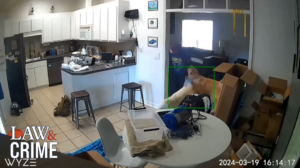
KITCHEN SECURITY VIDEO
Gregg can be seen letting the dogs in, going to one side of the house, then walking into a different area of the house, and coming back hiding her hands behind her back. She walks in the direction where Ashley Smylie had just gone in previous video, and three gunshots and screams can be heard, then she walks back into the kitchen with her hands behind her back, puts something on the counter as she sits on a stool, then picks up her phone to start texting. The dogs are visibly upset.
INVESTIGATOR ZACHARY COTTON
Investigator Zachary Cotton, who was identified during cross examination with Camp as the lead investigator on the case, gave similar testimony to Burnell’s.
Additionally, he testified that one of Gregg’s friends had told Ashley Smylie at school that Gregg had a phone she wasn’t supposed to have, as Gregg was already in trouble and had her phone taken away. That friend also told Ashley Smylie that Gregg had “weed pens.” This conversation took place the day Smylie was killed, Cotton said.
Cotton testified that Smylie had been shot in Gregg’s bedroom, and that evidence found in the room included blood spatter on the television and a bullet hole in the wall.
DAVID WHITEHEAD
David Whitehead, a Forensic Scientist and Section Chief of Trace Evidence at the Mississippi Forensics Laboratory, testified to his findings of gunshot residue on samples from Carly Gregg’s hands. Whitehead said there was gunshot residue on both of Gregg’s hands.
NATHAN HOLLY
Nathan Holly, a forensic biologist specializing in DNA analysis, testified that buccal swabs of Carly Gregg’s left and right cheek match a partial DNA profile from a swab of the trigger of the Taurus revolver used to kill Ashley Smylie. Holly explained that the DNA does match Gregg’s DNA, within odds of 1 in 10 billion. He went on to explain that with only 8 billion people in the world, the odds could be even smaller than that, but the numbers are capped at 10 billion.
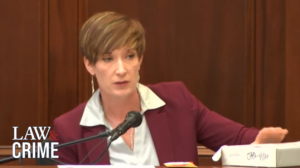
FELICIA MCINTIRE
Felicia McIntire, the Section Chief over the Firearm and Toolmark Division, testified that the bullets found in Ashley Smylie’s head matched the weapon found at the scene and allegedly used by Carly Gregg.
STATE MOTION REGARDING DEFENSE EXPERT
Once the jury was released, the State advised that they would have a motion on Wednesday regarding a defense expert. The judge asked why the motion had not already been handled, and Newman said there were things the expert was expected to say that were outside discovery. The court took a 5 minute recess and came back to discuss it.
Newman said the expert had told them that an interview with Heath Smylie was not turned over to the prosecution, and then that the expert had issued an opinion that the medication Lexapro had left Gregg in a “highly precocious” frame of mind, but that he couldn’t be sure it had anything to do with the shooting. Newman asked that the expert not be allowed to testify to the effect of the medication on Gregg’s mindset.
Judge Arthur asked Newman if the prosecution was able to interview Dr. Clark, and she said there was a Zoom call in which they asked him about his references and standards and discussed on-the-record statements about whether or not certain information would be used.
Camp told the judge that he does want the part of the report from the doctor that Lexapro had worsened Gregg’s mental illnesses submitted to the jury. The judge reiterated that the doctor also says that he can’t prove direct causality to the homicide, and Camp said he understood that.
Newman once again stated the prosecution’s position that there’s no probative value in the statements the doctor made about the Lexapro since he can’t prove it was the cause of the homicide.
Arthur said the statement itself doesn’t rise to the level that an expert is required to testify to in Mississippi, however whether the doctor is saying it’s related or not or if there’s inadequate information to prove direct causality… there seem to be two standards, he said.
“The state is free to cross appeal the court’s decision and it probably should, however this court has little faith that this court excluding a witness even though the was hired far past the deadline… and even though it does not rise to the standard” Arthur said, reluctantly overruling the state’s objection.
“Trial courts in this state are in a bad position. There are too many reversals when we exclude what is deemed to be the defendant’s case. This is not a case that this court wants to see again.”
“If there is a verdict in this case I’m inviting you to cross appeal,” Arthur said. “I am stating I believe I am wrong, but I’m wrong in the defendant’s favor. Alright, that’s going to be the ruling from the court.”
Newman told the judge there might be a similar argument when jury instructions are given.


